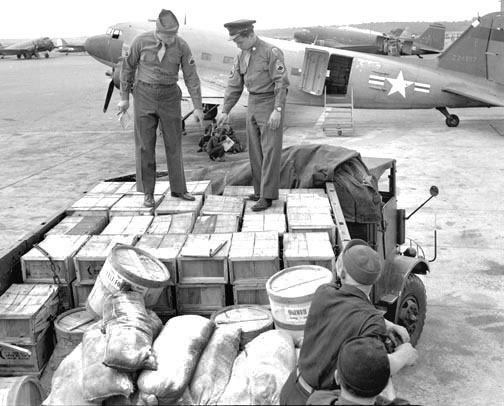The Berlin Blockade/Airlift
On 23 June 1948 all road, rail and canal links between West Berlin and West Germany were closed. The Russians’ aim was to force the West to withdraw from the city by reducing it to starvation point. Many Germans had lost their homes, the refugee crisis in Berlin was problematic, this caused chaos. Berlin had only food and fuel enough for six weeks.
The western powers, convinced that a retreat from West Berlin would be the prelude to a Russian attack on West Germany, were determined to hold on. General Clay, the American commander in Berlin, predicted that: “When Berlin falls, Western Germany will be next. If we withdraw our position in Berlin, Europe is threatened … Communism will run rampant.”
The West, therefore, decided to fly supplies into the city along the three air corridors permitted to the allies. They gambled that the Russians would not risk the outbreak of war by shooting the planes down. Despite several very close shaves, they were right. Over the next ten months 2 million tons of supplies were airlifted to the blockaded city in a remarkable operation that kept over 2 million West Berliners from starvation. Only in May 1949 did the Russians admit failure by lifting the Blockade, but by then there was no question that the old wartime alliance was over and the Cold War had begun.
iv) The Consequences of the Berlin Blockade
The consequences of the Berlin blockade were far reaching and were to dominate European politics for the next forty years. Pesident Truman was under no illusion that the Blockade had been a test of strength, designed by Stalin to see whether the West would resist and whether the USA would stand behind the Truman doctrine.
The Blockade certainly resulted in the final collapse of the wartime alliance and cooperation between the West and the Soviet Union. The ‘Iron Curtain’ that Churchill had seen descending across Europe in 1946 became ever more of a reality as both East and West endeavoured to secure their positions in Europe. Even so, it is also important to note that armed conflict did not result from the Blockade. The conflict was more of a struggle of will between the two sides, neither of which was prepared to risk direct military confrontation with the other. This was to set another pattern that was to last in Europe until the great upheavals of 1989. It was also a necessity since the Russians in late August 1949 exploded their own atomic bomb, much earlier than anyone had anticipated. East-West relations entered a new, and even more deadly phase.
In many ways the most important consequence of the Blockade was the formation of the North Atlantic Treaty Organisation (NATO) in April 1949. The Blockade had demonstrated the West’s military unreadiness and frightened them into making definite preparations. Already in March 1948 Britain, France, Belgium, Holland and Luxembourg had signed the Brussels Defence Treaty promising military collaboration in the event of war. Now they were joined by the USA, Canada, Portugal, Denmark, Ireland, Italy and Norway. All signed the North Atlantic Treaty, agreeing to regard an attack on one of them as an attack on them all and placing their defence forces under a joint NATO command structure. This was a highly significant development because it marked the abandonment of isolationism by the United States.
Finally, after the collapse of the Blockade, two separate German states came into being. Since there was no prospect of the Russians allowing a united and ‘free’ Germany to be created, the western powers went ahead alone and set up the Federal Republic of Germany. The Russians replied by establishing their own German state, the German Democratic Republic. In response to Marshall Aid, the Russians set up their own programme known as COMECON (Council of Mutual Economic Aid) under which Stalin was able to link the economies of all Russia’s satellites and influence their economies for the benefit of the Soviet Union. Each satellite produced what Stalin wanted it to, so that Poland, for example, concentrated on coal and steel. Finally in 1955 the Warsaw Pact was established after West Germany was admitted to NATO. The Pact was a military alliance between Russia and her satellites, but in practice it was more of a gesture against West German membership of NATO as there was already no doubt about the Soviet’s influence and control over the armed forces of her satellites. Problems surrounding Berlin did not go away. It led eventually to the construction of the Berlin Wall when Khruschchev challenged President Kennedy.
In brief then, the main consequences of the Berlin Blockade were:
* Deterioration of East-West relations to their worst point since 1945, escalating the early stages of the Cold War.
* Psychological boost for the western powers (having succeeded in defending Berlin)
* The formation of NATO and the coordination of the West’s defences
* Division of Germany: the establishment of the German Federal Republic in August 1949 and the German Democratic Republic in September 1949
* Long-term commitment of the USA to the protection of Europe: military garrisons in NATO countries


